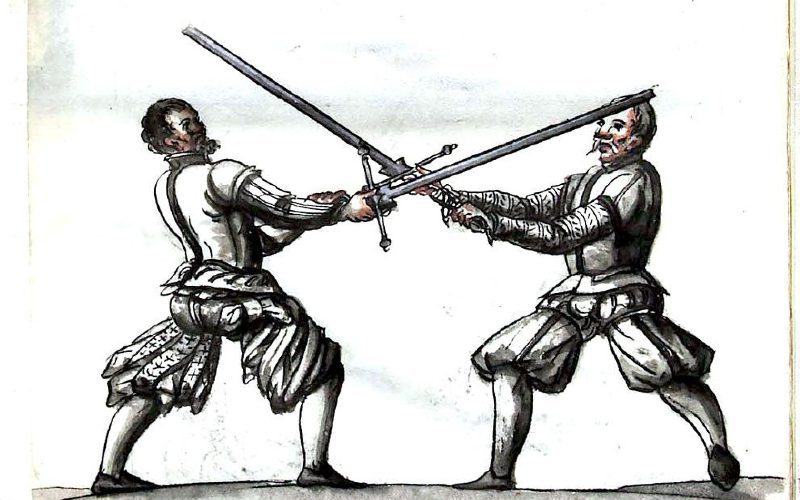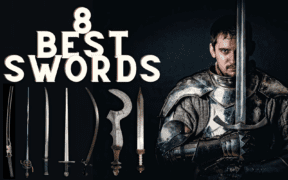Types of Greatswords and Their Historical Significance
NO AI USED This Article has been written and edited by our team with no help of the AI

Greatswords were specialized infantry weapons of the 16th century. These formidable weapons, distinguished by their long blades and extended grips, have left a lasting legacy in the history of weaponry. In this article, we’ll delve into the different types of greatswords and their pivotal roles in shaping the military strategies and tactics of their era.
What Exactly Are Greatswords?
A greatsword is a two-handed sword designed to be wielded with both hands. It is too large to be worn on a belt, with its grip and crossguard being very long in proportion to its blade. In his book The Use of Medieval Weaponry, historical fencing instructor Eric Lowe describes greatswords as being approximately the height of a man or at least reaching the height of one’s chin.
Greatswords are large swords, though they are not as heavy as they might appear, with an average weight ranging from 5 to 8 pounds (about 2.2 to 3.6 kg). The length of the hilt and crossguard was crucial for balancing their weight. Historian William J. McPeak, in his discussion of two-handed swords, noted that hilts needed to be at least 9 inches (22 centimeters) long to counterbalance blades that could measure up to 45 inches (114 centimeters) or more.
Famous Greatswords in History
Greatswords were formidable weapons employed in various combat situations, such as defending castle or town walls, engaging in single combats, and protecting standards or banners. In the 16th century, German Landsknechts famously used them to disrupt and break up enemy pike formations.
Here are some of the most famous greatswords in history:
1. Zweihander (German)

The German term “zweihänder” translates as “two-hander” and is a relatively modern name for the German greatsword. In historical texts, it is referred to as bidenhänder or doppelhänder, meaning both-hander and double-hander, respectively.
In the 16th century, the German Landsknechts adopted the zweihänder to smash their way into enemy ranks. The doppelsöldner (double pay-men) independently attacked the pike units, creating gaps in the enemy’s formation, and received extra wages for fighting on the front line.
The zweihänder is characterized by its slim, long, straight blade, or occasionally wavy, flame-like blades, and parrying hooks. It later assumed ceremonial or bodyguard functions. Parade swords (paratschwert) and bearing swords are longer, heavier, and more ornate than those used on the battlefield.
2. Claymore (Scottish)

In the 16th century, Scottish Highlanders developed a distinctive type of two-handed sword called the claymore. The name claymore is derived from the Scottish Gaelic claidheamh mór, meaning great sword.
The Highland Claymore is notable for its straight, downward-sloping crossguard and the openwork quatrefoil design at the end of the cross’s arms. It was extensively used throughout the era of clan warfare and during border conflicts with England from 1400 to 1700.
3. Lowland Sword (Scottish)

Lowland Scots used the two-handed sword known as the Lowland sword, the largest and heaviest of all Scottish two-handed swords. It is distinguished by its long crossguards, which have downturned ends and ring guards. However, Ewart Oakeshott notes that it’s uncertain if it was exclusively used in the Lowland region.
In his discussion of Scottish two-handed swords, Tony Willis, an expert from the American Society of Arms Collectors, notes that the enormous size of the Lowland sword required extensive training for effective use, making it impractical for general soldiers. Instead, it was a prominent part of the Lowland armory, carried by individuals representing royal authority and serving both as a weapon and a symbol of status.
4. Clamshell-Hilted Sword (Scottish)

Most notable for its shell-shaped guard, the Clamshell-hilted sword is a smaller two-handed sword suited for all-round skirmishing. During the 16th century, it was widely used across the Scottish Lowlands, particularly in areas remote from central authority. The riding clans, known as the Border Reivers, controlled local territories and frequently engaged in feuds, making the Clamshell-hilted sword an effective weapon for raiding, ambushing, and small-scale skirmishing.
5. Montante/Spadone (Iberian/Italian)
The terms montante and spadone refer to the same type of two-handed sword, though they have different names in Iberian and Italian contexts. Their shapes and styles may vary with regional differences, but both are great swords used with both hands.
An Iberian montante is characterized by its large size and wide quillons (arms of the crossguard). The name montante likely derives from the Italian word “montare,” meaning to rise or to go up, possibly because the sword is wielded high or is as tall as a man.

The montante was used both on foot and on the battlefield, notably by Spanish soldier Diego Garcia de Paredes during the Italian Wars. It was also employed in urban civilian contexts, such as defending goods in transit and by masters-at-arms for teaching and separating duels between fencers.
The Italian spadone had no legal prohibitions and was commonly carried in various ways at the owner’s discretion for defense on ordinary streets. It was also occasionally used in sea battles, such as during the Siege of Koroni in Greece.
6. English Greatsword

Historian Ewart Oakeshott noted a distinctive group of late 15th- and early 16th-century two-handed swords that are possibly of English origin. English two-handed swords are characterized by a long grip in proportion to the blade, which is sharply tapered with a flattened diamond cross-section, and long crossguards with knobbed ends. Some also feature well-formed ecussons over the blade.
The English greatsword was sometimes called slaughter swords, a term derived from the German “schlachtschwerter,” meaning battle swords. It was a specialized weapon, deadly in infantry combat. In Tudor England, officers who carried two-handed swords were known as whifflers, whose role was to maintain order in processions.
Conclusion
Greatswords, or two-handed swords, were not medieval weapons but truly belonged to the 16th century. These two-handed swords served as formidable weapons in infantry combat and were also employed in defending standards or banners. Additionally, they were used for civilian self-defense and in various ceremonial roles.





